Making Ceramics in Ollantaytambo
26 November, 2007, 05:59 pm in "Peru"
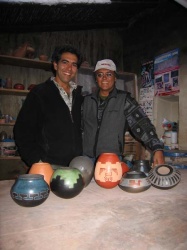 While we were in Ollantaytambo in November, we visited the Catcco musum and Lucho Soler's workshop. Lucho lived in Santa Fe (New Mexico) for 20 years. His goal for his students is to create very fine pottery and make new artists as well as making Ollantaytambo known as the place where the best Peruvian pottery is made. Also, he wants to raise the quality of Peruvian pottery to the same level as achieved by their ancestors.
While we were in Ollantaytambo in November, we visited the Catcco musum and Lucho Soler's workshop. Lucho lived in Santa Fe (New Mexico) for 20 years. His goal for his students is to create very fine pottery and make new artists as well as making Ollantaytambo known as the place where the best Peruvian pottery is made. Also, he wants to raise the quality of Peruvian pottery to the same level as achieved by their ancestors.When I asked about studying ceramics with him, he said that we could do classes for two or three weeks. I started the class on November 12th.
Lucho and all of his students make their pots manually, same as Pueblo people in New Mexico. There was also a kickwheel. My plan was to make a few pieces using the wheel and also manually. The first week, I made 8 pots using the wheel.
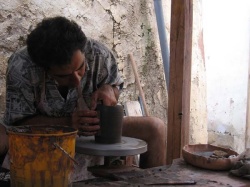
Because it is difficult to buy clay in the area, most of the artists make their own clay. Lucho finds his clay around Cusco. I was always wondering about making my own clay and this was a great opportunity to learn the process. Lucho gave me the raw clay and sand and showed me what needs to be done. Making clay was a long and fun process which took 4 days.
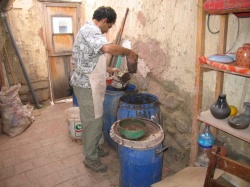
This way my own clay was ready for the second week when I did three pots manually.
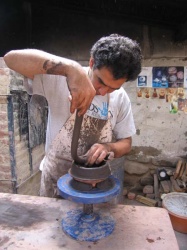
I used a river stone to burnish the pots both before/after glazing. Burnishing is very important part of this art if you want to have good looking results. Also it is tricky and needs to be done at the right time and diligently. Basically, the more the pot is burnished, the shinnier it will become.
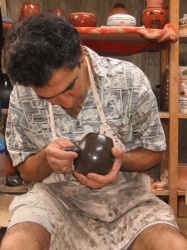
I used three colors (green, blue and red oxide) in a few of the pots. I finished all the design (carving, glazing) in the second week.
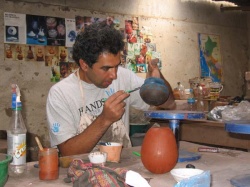
Since some of the pots were still wet, I put them outside under the sun to dry them.
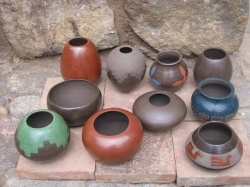
However, the weather was changged from sunny to rainy soon after about two hours sitting outside guarding the pots. Lucho decided to dry them in electric kiln for about 2 hours and then fired them for three hours. The color of the pots at this time was earthy.
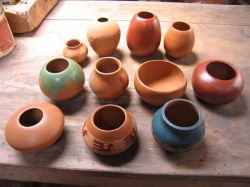
The next step was to process the pots with smoke to make them black. In Chulucanas, potters use special slip to cover the parts that they don't want to be black and smoke the pots. I also prepared my own slip and covered the glazed parts (colored parts). The smoking process is very interesting. Lucho has made a special kiln for that. The pots were warmed up for about an hour and then cow manure was used in a tray above the pots which caused a lack of oxygen which as a result made the pots black. Here are before and after pictures of smoking.
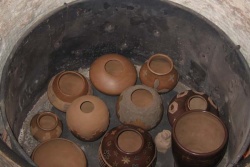
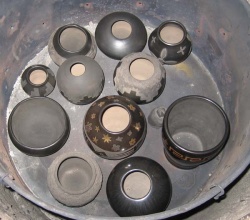
This kind of pottery was always in my mind when I first saw the pots of New Mexico. I am so glad that I learned a lot about the complete process: from making the clay to burnishing/carving/smoking the pots.
Lucho is a very talented and experienced artist. Here is one of his works of art before and during smoking process when he was taking the piece out.
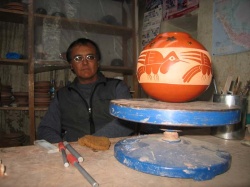
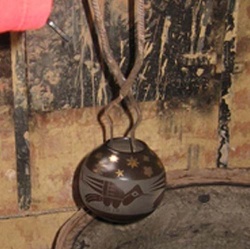
Comments
- Comments
Powered by My Blog 1.69. Copyright 2003-2006 FuzzyMonkey.net.
Created by the scripting wizards at FuzzyMonkey.net..
(Code modified by Rowshan Dowlatabadi)
Created by the scripting wizards at FuzzyMonkey.net..
(Code modified by Rowshan Dowlatabadi)

